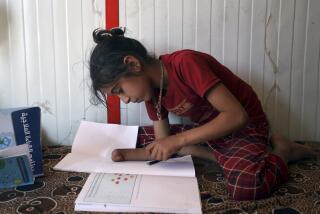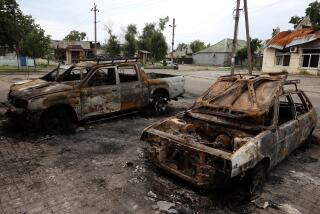Ban the cluster bomb
- Share via
More than half the world’s nations are meeting in Oslo on Wednesday to sign a global treaty banning cluster bombs. Although my government won’t be there, I will.
I have a personal stake in this treaty. My son, Travis, a corporal in the Marines, was killed by one of our own cluster bomblets in July 2003. He was clearing an Iraqi farmer’s field near Karbala of unexploded ordnance when one of the men from his unit mishandled a cluster submunition. It exploded, killing Travis and taking an eye and an arm from the Marine who touched it.
When the military informed me of Travis’ death, they did not tell me that the “explosive device” was a U.S. cluster submunition; men in Travis’ unit filled in that blank. It was the first I had heard of cluster bombs. In the ensuing five years, I have learned enough to know that I do not want my country using these weapons to protect me -- or our soldiers.
Cluster bombs scatter hundreds of small, unguided explosives over an area as big as several football fields. Usually, some of these small bombs, or submunitions, fail to explode when they hit the ground. These mini-bombs lie in wait like land mines, sometimes for years, unable to distinguish between a soldier and a child.
The weapons were developed during World War II for use against tanks on vast, unpopulated plains of warfare. They were never intended to be used in cities, villages or even agricultural areas.
But they are. In the last 10 years, the United States has used cluster bombs in civilian-populated areas of Afghanistan, Iraq and Kosovo. Israel used them on the villages and olive groves of southern Lebanon. And the United States rained cluster bombs on Laos in a secret side war to Vietnam. The “bombies” in Laos are still exploding, 30 years after that war.
The Bush administration and the Pentagon say that cluster bombs are needed to protect American soldiers. I say that the cost to local civilians is too high and that U.S. cluster munitions also directly endanger U.S. troops. During the Persian Gulf War, according to the Government Accountability Office, our own cluster bombs killed or injured 80 U.S. troops who had to pass through desert areas scattered with hidden dud cluster submunitions. Professional de-miners and combat engineers see cluster submunitions as the most dangerous kind of unexploded ordnance to clear because they are designed to pierce armor and are very volatile.
I recently met a young man from Afghanistan named Soraj. In December 2001, while celebrating a holiday with cousins and friends, he picked up a bright yellow object on the ground. It was a U.S. cluster submunition. It exploded, ripping off both of his legs and one of his fingers. He was 10 years old.
I realized that our stories are linked. Travis died so that an Iraqi farmer, or that farmer’s child, would not have to suffer as Soraj did. This is a sacrifice no one should have to make.
Among the more than 100 governments that will gather in Oslo are nearly all of our NATO allies, including Britain, France and Germany. These countries, fighting alongside the U.S. in Afghanistan, have decided that they can protect their troops without weapons that pose a terrifying and avoidable threat to civilians during and long after the battle.
President-elect Barack Obama will face many pressing problems when he takes office. This is one with a simple solution -- sign the Convention on Cluster Munitions soon after taking office and then push the Senate to ratify it. He should see it as part of helping to repair the United States’ damaged global reputation and reasserting U.S. moral leadership.
This treaty will not give Soraj back his legs, and it will not bring me back my son. But it will save the lives and limbs of other civilians -- and U.S. soldiers.
More to Read
Sign up for Essential California
The most important California stories and recommendations in your inbox every morning.
You may occasionally receive promotional content from the Los Angeles Times.










